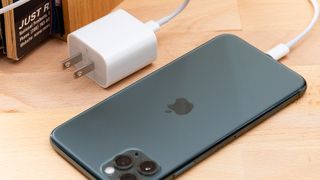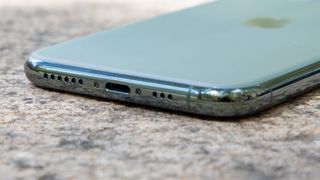Apple says killing Lightning port would create waste, forgets about millions of headphones it made obsolete
It's all about 'courage,' apparently

The European Parliament really wants Apple to say goodbye to its Lightning port, a USB connection standard used only by the company's own iPhones, iPads and Beats headphones.
EU lawmakers argue that there's an environmental cost to locking in consumers with proprietary ports. People end up being forced to buy a second cable where only one should have sufficed, and that cable duplication produces waste. (More than 51,000 metric tons of it, as a matter of fact, according to the EU's data.)
The dream of an iPhone with a USB Type-C port, just like those on Android phones, perpetually hovers in the distance, like a vision of a future that will never come to pass. But that's not news.
What's interesting is Apple's counter-intuitive counterargument to the EU: that ditching the Lightning standard will generate more waste, not less.
The Lightning lock-in
Let's backtrack for a moment. The European Parliament has been pushing for "a common charger [that] should fit all mobile phones, tablets, e-book readers and other portable devices" since 2012, when the EU first released its Radio Equipment Directive — the same year that Apple introduced the Lightning port.
That EU directive helped unify most of the smartphone industry behind micro-USB (officially, USB Micro) ports, and then behind USB-C when that standard came along. But it stopped short of fully solving the universal-compatibility problem.
As it turns out, merely encouraging companies to cooperate for the benefit of users and the environment doesn't always yield the desired results.
Apple was able to steer clear of complying with the EU mandate by offering a micro USB-to-Lightning adapter, according to the BBC. Indeed, Apple still sells this loophole-creating device for only $19. (Off-brand ones cost $2 on Amazon.)
If everyone else is doing it, we don't need to
Yet, that didn't change the fact that iPhones themselves still had a hole that fit a proprietary plug that was different from the one everyone else was using.
While the latest, most expensive iPhone models support USB-C in a sense — their outlet plugs have a USB-C port — it's the other side of the cable that really matters, because that's what determines the cable you buy.
Nevertheless, in a statement quoted by the BBC, Apple claimed it "[does] not believe there is a case for regulation given the industry is already moving to the use of USB-C through a connector or cable assembly."
Additionally, because the company has shipped a self-proclaimed billion-plus devices that employ Lightning, it's arguing that having to move to a common standard now would actually be antithetical to the EU's anti-waste objective.
That point isn't totally without merit. Chances are even those of us that carry Android phones have a Lightning cable or two lying around. Given that the standard has existed since 2012, eight years has given the public a very long time to invest in the technology.

Planned obsolescence in the name of courage
But I'd have an easier time seeing Apple's side if Apple hadn't made me dump all my 30-pin iPhone-connector accessories in the move to Lightning in 2012. Or if it didn't drive me to buy handfuls of those fiddly little USB-A to USB-C adapters for its laptops, when it also decided that dedicating space to a microSD card slot was out of the question for some reason.
This is the same Apple that abandoned the 3.5-millimeter headphone jack in its smartphones — a perfectly good interface that no one ever complained about — in the name of "courage." The same Apple that peddles tiny wireless earbuds that cost $159 and lose half their battery life in two years, while your old, trusty cans gather dust — if you haven't already chucked them, that is.
Look, technological innovation generates waste. We know this. But Apple's propensity to drop still-relevant standards long before other industry players do doesn't appear to be motivated by innovation, at least outwardly.
What does Lightning allow that USB-C doesn't? How would have continuing to accommodate 3.5-millimeter headphones impeded the development of AirPods? Who would have complained if the new-for-2016 MacBook Pro hollowed out a little space to accommodate USB-A, or was made a smidge thicker as a consequence?
There are some rumors surrounding the iPhone 12 — as there were around last year's iPhone, and the one before that — that it will be the first to scratch Lightning in favor of USB-C. But why would Apple fight the EU's campaign if it were going that route?
A likelier scenario is that Apple ditches all ports entirely, making future iPhones fully reliant on wireless charging and data transfer, as analyst Ming-Chi Kuo relayed to MacRumors late last year.
That likely won't happen in time for this year's iPhones. But when it does, someday, I'll be waiting to see how Apple rationalizes all those suddenly obsolete Lightning accessories destined for landfills.
Sign up to get the BEST of Tom’s Guide direct to your inbox.
Upgrade your life with a daily dose of the biggest tech news, lifestyle hacks and our curated analysis. Be the first to know about cutting-edge gadgets and the hottest deals.
Adam Ismail is a staff writer at Jalopnik and previously worked on Tom's Guide covering smartphones, car tech and gaming. His love for all things mobile began with the original Motorola Droid; since then he’s owned a variety of Android and iOS-powered handsets, refusing to stay loyal to one platform. His work has also appeared on Digital Trends and GTPlanet. When he’s not fiddling with the latest devices, he’s at an indie pop show, recording a podcast or playing Sega Dreamcast.
